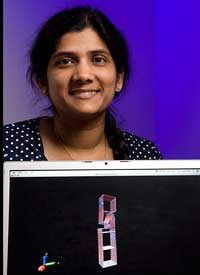Yashashree Kulkarni, an assistant professor of mechanical engineering, has received a 2010 Young Faculty Award from the Defense Advanced Research Projects Agency (DARPA).
The award is given annually to junior faculty by DARPA, the research arm of United States Department of Defense. The program is designed to recognize talented researchers whose work will help develop solutions that could enhance security.
“Since it’s a young faculty award, I was quite excited to receive it,” said Kulkarni. “I’m looking forward to the fact that it is going to help me establish a stronger research program and work on exciting research problems associated with nanostructured materials.”
Through computational modeling, Kulkarni is working to develop a new class of materials that could make metals stronger and more ductile. During the course of the next two years, she will use the $226,358 grant to fund work that will help her gain further insight into these nanotwinned materials.
Kulkarni's study of these materials will build on previous work by researchers to create other high-strength materials by incorporating nanoscale crystalline grains into a materials microstructure.
“The grain boundaries created, due to the mismatch of orientation between adjacent grains, can eventually become sources of defects leading to a loss of stability and strength,” she said of these studies to achieve the effects of increased strength in nanocrystalline materials. “Nanotwinned metals contain a very special class of grain boundaries known as twin boundaries. They have unique properties owing to the fact that the grains on either side of a twin boundary are ‘twins,’ or mirror images of each other. “
The twin boundaries in nanotwinned metals block defects in the crystal structure, making the metal stronger and more flexible.
Yet, issues related to their stability and fracture are still not well understood. So Kulkarni is using computational modeling to perform simulations, at the atomic level, to see how the response of these materials changes with different temperatures and in the presence of cracks.
“Looking at the stability of these nanostructures is a very important aspect if these materials are to be synthesized and used for practical applications,” she said, noting they could be used in everything from stronger armor and corrosion resistant coatings to medical implants.
Kulkarni earned her bachelor’s degree in civil engineering from the Indian Institute of Technology in 2001. She obtained both her master’s and Ph.D. degrees in applied mechanics from the California Institute of Technology in 2002 and 2006, respectively. Before accepting a faculty position at UH in 2009, she spent two years as a postdoctoral researcher at the University of California, San Diego where she first began her work with nanotwinned materials.
